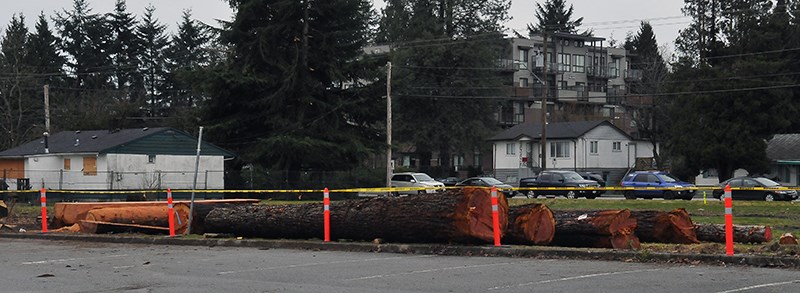Port Coquitlam is looking to add 13,000 more small trees on private and public lands over the next 25 years.
The move to boost the city's tree canopy and to better protect heritage trees comes three months after it chopped dozens of trees for the Port Coquitlam recreation complex — some of them classified as "significant."
Last week, PoCo's finance and intergovernmental committee heard from the Tree Regulation and Policy Review Team — made up of three parks and two planning staff members — about the overall "net loss" of trees in the community due to tree cutting.
To stem the tide, the team is making a number of recommendations that will be put out for public feedback this summer.
Among the suggestions is to either keep the tree canopy to a 23.8% coverage, or to raise the target to 25% over the next 25 years.
A tree canopy — the above-ground portion of a tree — is a measure of plant cover in the city and is a major indicator of urban environmental health. Research shows a canopy of 40% is one aspect of a city being considered "environmentally friendly."
PoCo's proposal to increase the tree canopy to 25% by 2042 follows recent goals set in other Metro Vancouver jurisdictions:
• New Westminster is aiming to hike its canopy coverage from 18% to 27% by 2035;
• Surrey's target will jump by 12.3% from 27.7% to 40% by 2058;
• and Vancouver's is looking for a 4% increase to 22% by 2050.
Coquitlam hasn't measured its tree canopy since 2006, which at the time was a healthy 39% (at Monday's meeting, city council adopted its parks, recreation and cultural master plan for 2015-'30 that includes forestry management).
Neil MacEachern, PoCo's environmental co-ordinator, told PoCo's finance committee the overall net loss of trees ranges from 50 to 1,500 trees a year, with new developments taking the largest chunk.
Up to 2,000 trees a year are cut under permits, and replanting — by the city, developers and homeowners — only partially offsets that number, he said.
The team is suggesting a number of measures to mitigate the tree loss:
• planting 13,000 more small trees or 4,000 medium-sized trees (the city has yet to provide a cost);
• charging developers and homeowners for tree cutting (currently, the city allows one tree to be cut a year per lot, without a fee);
• doubling the tree-cutting permit fee to $100;
• boosting penalties for trees cut illegally;
• and taking a security for a tree replacement.
There are also proposals to better protect significant trees and to offer tax breaks to homeowners who keep large trees on their land.
Another suggestion is to mandate two trees be planted for every tree cut — or the person cutting has to provide a cash-in-lieu replacement. Such a policy is in effect in Surrey, where the money goes into a municipal "green fund" that pays for tree replanting; last year, Surrey's fund generated $1.46 million.
PoCo Coun. Glenn Pollock told the finance committee the city will struggle with status quo. Many trees in Quebec and Ontario have rotted due to pest infestations "and it's only a matter of time before it happens to us," he said.
Mike Bowen, a former city councillor who was at the June 15 meeting, also said recent windstorms have also contributed to the net loss.
Trees close to rivers and creeks also need extra protection, Coun. Laura Dupont added. "We are one of the few cities in the Lower Mainland that still have salmon-bearing creeks," she said.
PoCo currently has 5.6 million trees, about 55% of which are on private property.



